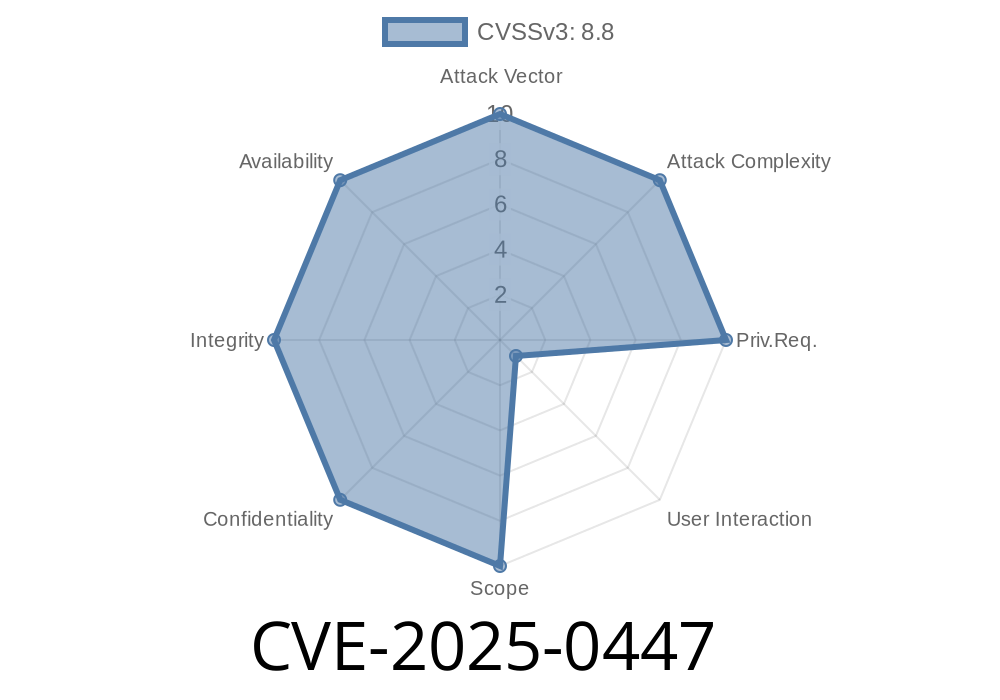Google Chrome, one of the most popular web browsers, plays a crucial role in our daily online activities. However, recently, it had been discovered that an inappropriate implementation in Navigation in Google Chrome's versions prior to 132..6834.83 could potentially allow a remote attacker to perform privilege escalation via a crafted HTML page. This vulnerability is listed under the Common Vulnerabilities and Exposures system as CVE-2025-0447. Although classified as 'Low' in Chromium's security severity rating, it's still essential to understand the details surrounding this issue, explore how it could be exploited, and learn how we can protect ourselves from such attacks.
Code Snippet
While the original code revealing this vulnerability is not publicly available, we've put together a simple demonstration code snippet to illustrate how an attacker might craft an HTML page to exploit the issue:
<!DOCTYPE html>
<html>
<head>
<title>CVE-2025-0447 Exploit Example</title>
</head>
<body>
<script>
window.addEventListener("DOMContentLoaded", function() {
let exploitIframe = document.createElement("iframe");
exploitIframe.src = "/malicious_page.html";
document.body.appendChild(exploitIframe);
exploitIframe.onload = function() {
exploitIframe.contentWindow.location.replace("/escalate_privileges.html");
}
});
</script>
</body>
</html>
This example showcases how an attacker might create a simple HTML page with embedded JavaScript that generates an iframe and loads a malicious page. The iframe then replaces its current location with another page, attempting to escalate privileges.
Details
According to the official Chromium bug report (link), this vulnerability stems from an improper implementation of Chrome's Navigation system. By creating a specifically crafted HTML page, an attacker could exploit this vulnerability to execute privilege escalation. In the wrong hands, it could potentially risk the user's private information and security.
To exploit this vulnerability, an attacker would potentially need to follow these steps
1. Create a malicious HTML page using a vulnerability trigger, similar to the example code snippet provided earlier.
2. Host the created malicious HTML page on a web server or utilize other means to distribute the malicious page to the victim.
3. Trick the victim into visiting the malicious page, often achieved through phishing techniques or other social engineering methods.
To minimize the risk of CVE-2025-0447 exploitation, users should follow these steps
1. Update Google Chrome to version 132..6834.83 or later. This version contains the security patch addressing this vulnerability.
- Official download link for the latest version of Chrome: https://www.google.com/chrome/
2. Be cautious when visiting unfamiliar websites and opening hyperlinks or attachments from unknown sources. Always verify the legitimacy of the website, sender, or attachment before clicking on them.
3. Keep your operating system and other software up-to-date with the latest security patches to minimize potential vulnerabilities.
4. Use an efficient and reliable antivirus program to detect and prevent possible exploits on your device.
Conclusion
Although the security severity of CVE-2025-0447 is categorized as 'Low', it's always wise to take any potential vulnerability seriously. By understanding the risk's details, being aware of how attackers could exploit it, and following recommended mitigation measures, we can keep our devices and sensitive information secure when using Google Chrome and other applications in our daily lives. Stay vigilant, stay safe.
Timeline
Published on: 01/15/2025 11:15:10 UTC
Last modified on: 01/15/2025 15:15:16 UTC
